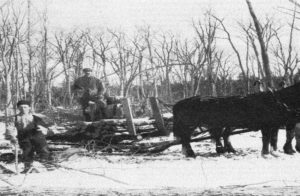 If you follow the North Simcoe Rail Trail east from George Johnston Road, near Minesing, you just might find the remains of the old hamlet of Josephine, one of the small handful of ghost towns scattered across Simcoe County.
If you follow the North Simcoe Rail Trail east from George Johnston Road, near Minesing, you just might find the remains of the old hamlet of Josephine, one of the small handful of ghost towns scattered across Simcoe County.
Josephine began in 1879 when Joseph Budd established a sawmill, a commissary and a few houses for his employees on lots 11 and 12 in the 9th concession of Vespra. Budd named the tiny hamlet after his daughter.
Budd was the last of three lumbermen who harvested the virgin white pine forests that grew around what is now the village of Minesing. The ancient forest was bounded on the south by an escarpment stretching west from Dunn’s Hill and on the west by the Minesing Swamp.
The first of the lumbermen to operate in this area was George Ball, who built a mill on Willow Creek about a mile downstream of the Mill Road (now Highway 27) bridge around 1855, shortly after the arrival of the Northern Railway in Allandale created a market for lumber in the area.
Later, Gideon Shortreed built a mill on the 7th line of Vespra near where it crossed the Northern Railway (now CPR) line.
After these first two lumbermen had completed their work, most of the area had been deforested, leaving fields covered in four- or five-foot-wide stumps.
Although the best trees in the area had already been cut, some decent lumber — white pine mixed with oak, maple and ash — remained growing along the edges of the Minesing Swamp. However, for many years this area remained untouched because there was no easy way to transport the lumber to market. The construction of the North Simcoe Railway (later part of the Canadian National Railway) in 1879 changed that, and Joseph Budd set up operations in the area that same year.
Budd established himself on 200 acres of land that was neatly dissected by the North Simcoe Railway line. To the east of the railway, he built his mill and the houses for his workers. Budd constructed a house for himself to the west of the railway, facing the mill that provided his livelihood.
Although Josephine boasted a commissary where Budd’s employees could buy personal items, for the first few years there was no post office or general store available to them. Instead, a road was opened from the 9thLine of Vespra to the 7th, known then as Budd’s Road and later as Snow Valley Road. From there, prospective customers would follow a winding track through the fields of stumps to the general store and post office of George Sneath, near the junction of what are now Highways 26 and 27.
In those early years, the closest school to Josephine was in Minesing, which was hard to reach outside winter given the poor state of the roads through the swamp. The village of Minesing, with five churches and no tavern, also held little appeal for Budd’s millworkers on their days off. Instead, most locals travelled to Midhurst for their entertainment, except on Saturdays, when they could catch the train to Barrie for the day.
For years, Josephine was a “flag stop” for the Saturday morning train travelling from Allandale to Penetanguishene along the North Simcoe Railway. Being a flag stop meant that the train would only stop at the local station if it was “flagged” or signalled to do so, otherwise it would continue on past the station without stopping. Josephine’s train station was commonly known as “Budd’s” or “Budd’s Mill.”
Joseph Budd opened Josephine’s first and only post office in 1884, with himself as postmaster. The same building also served as the hamlet’s local school as well as a Methodist church.
A fire swept through Josephine in 1885 and destroyed almost everything, but the town was quickly rebuilt. The post office closed for good in 1894.
After the largest trees had been cut, Budd’s mill was bought by Charles Wright and converted to the manufacture of shingles and staves, which it continued to do until as late as 1914.
Not much is left of Josephine today. Intrepid explorers may be lucky enough to find remains of the hamlet and mill to the east of the trail and of Joseph Budd’s house to the west. Ironically, after a hundred years, a hamlet built on the lumber trade has been swallowed up again by the forest.
By John Merritt for the SCHA.
Photo: Three men cutting lumber in the Minesing Swamp, circa 1910. For many years the swamp and surrounding forests supplied lumber for mills like Joseph Budd’s. From A History of Vespra Township (Township of Vespra, 1987).